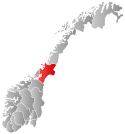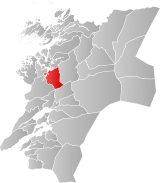Klinga (municipality)
 From Wikipedia the free encyclopedia
From Wikipedia the free encyclopedia
Klinga Municipality Klinga herred | |
|---|---|
| Klingen herred (historic name) | |
 Nord-Trøndelag within Norway | |
 Klinga within Nord-Trøndelag | |
| Coordinates: 64°24′35″N 11°28′56″E / 64.40972°N 11.48222°E | |
| Country | Norway |
| County | Nord-Trøndelag |
| District | Namdalen |
| Established | 1 Jan 1891 |
| • Preceded by | Vemundvik Municipality |
| Disestablished | 1 Jan 1964 |
| • Succeeded by | Namsos Municipality |
| Administrative centre | Bangsund |
| Area (upon dissolution) | |
| • Total | 352 km2 (136 sq mi) |
| Population (1964) | |
| • Total | 2,482 |
| • Density | 7.1/km2 (18/sq mi) |
| Demonym | Klingbygg[1] |
| Time zone | UTC+01:00 (CET) |
| • Summer (DST) | UTC+02:00 (CEST) |
| ISO 3166 code | NO-1746[2] |
Klinga is a former municipality in the old Nord-Trøndelag county, Norway. The 352-square-kilometre (136 sq mi) municipality existed from 1891 until its dissolution in 1964. The municipality encompassed the mainland areas south of the river Namsen in what is now the municipality of Namsos in Trøndelag county. The administrative centre was the village of Bangsund. Other villages in Klinga included Spillum and Klinga where Klinga Church is located.[3]
History[edit]

The municipality of Klingen was established on 1 January 1891 when the municipality of Namsos herred was divided in two. The northern part became the municipality of Vemundvik (population: 1,387) and the southern part became the municipality of Klingen (population: 1,387). In 1917, the name of the municipality was changed to Klinga.[4]
During the 1960s, there were many municipal mergers across Norway due to the work of the Schei Committee. On 1 January 1964, the neighboring municipalities of Vemundvik (population: 2,040) and Klinga (population: 2,482) plus the parts of Otterøy municipality located north of the Namsenfjorden (population: 1,013) and the Finnangerodden area on the island of Otterøya in Fosnes municipality (population: 116) were all merged with the town of Namsos (population: 5,224) to create a new (much larger) municipality of Namsos with 10,875 residents.[4]
Name[edit]
The municipality (originally the parish) is named after the old Klingen farm. The name is a form of the Old Norse word kringla which means "circle" or "orb". This name likely refers to the round-shaped mountain located behind the farm site.[5] Historically, the name of the municipality was spelled Klingen. On 3 November 1917, a royal resolution changed the spelling of the name of the municipality to Klinga.[6]
Government[edit]
While it existed, this municipality was responsible for primary education (through 10th grade), outpatient health services, senior citizen services, unemployment, social services, zoning, economic development, and municipal roads. During its existence, this municipality was governed by a municipal council of elected representatives, which in turn elected a mayor.[7]
Mayors[edit]
- 1891–1907: Halvdan Romstad (V)
- 1908–1913: Eirik Spillum (LL)
- 1914–1916: Karl Klingen (Rp)
- 1917–1922: Ole Schiefloe (LL)
- 1923–1925: Nils Christian Pehrson (Ap)
- 1926–1939: Martin Tørring (Ap)
- 1940–1954: Konrad Aagesen (Ap)
- 1955-1955: Arne Kvam (Ap)
- 1956–1961: Sverre Lindseth (Ap)
- 1962–1963: Alf Derås (Ap)
Municipal council[edit]
The municipal council (Herredsstyre) of Klinga was made up of 15 representatives that were elected to four year terms. The party breakdown of the final municipal council was as follows:
| Party name (in Norwegian) | Number of representatives | |
|---|---|---|
| Labour Party (Arbeiderpartiet) | 10 | |
| Communist Party (Kommunistiske Parti) | 1 | |
| Christian Democratic Party (Kristelig Folkeparti) | 1 | |
| Centre Party (Senterpartiet) | 1 | |
| Joint List(s) of Non-Socialist Parties (Borgerlige Felleslister) | 2 | |
| Total number of members: | 15 | |
| Party name (in Norwegian) | Number of representatives | |
|---|---|---|
| Labour Party (Arbeiderpartiet) | 9 | |
| Communist Party (Kommunistiske Parti) | 1 | |
| Christian Democratic Party (Kristelig Folkeparti) | 1 | |
| List of workers, fishermen, and small farmholders (Arbeidere, fiskere, småbrukere liste) | 1 | |
| Joint List(s) of Non-Socialist Parties (Borgerlige Felleslister) | 3 | |
| Total number of members: | 15 | |
| Party name (in Norwegian) | Number of representatives | |
|---|---|---|
| Labour Party (Arbeiderpartiet) | 6 | |
| Communist Party (Kommunistiske Parti) | 1 | |
| Christian Democratic Party (Kristelig Folkeparti) | 1 | |
| List of workers, fishermen, and small farmholders (Arbeidere, fiskere, småbrukere liste) | 2 | |
| Local List(s) (Lokale lister) | 2 | |
| Total number of members: | 12 | |
| Party name (in Norwegian) | Number of representatives | |
|---|---|---|
| Labour Party (Arbeiderpartiet) | 6 | |
| Communist Party (Kommunistiske Parti) | 2 | |
| Christian Democratic Party (Kristelig Folkeparti) | 1 | |
| Joint List(s) of Non-Socialist Parties (Borgerlige Felleslister) | 3 | |
| Total number of members: | 12 | |
| Party name (in Norwegian) | Number of representatives | |
|---|---|---|
| Labour Party (Arbeiderpartiet) | 7 | |
| Communist Party (Kommunistiske Parti) | 2 | |
| Joint List(s) of Non-Socialist Parties (Borgerlige Felleslister) | 3 | |
| Total number of members: | 12 | |
| Party name (in Norwegian) | Number of representatives | |
|---|---|---|
| Labour Party (Arbeiderpartiet) | 8 | |
| Joint List(s) of Non-Socialist Parties (Borgerlige Felleslister) | 4 | |
| Total number of members: | 12 | |
| Note: Due to the German occupation of Norway during World War II, no elections were held for new municipal councils until after the war ended in 1945. | ||
See also[edit]
References[edit]
- ^ "Navn på steder og personer: Innbyggjarnamn" (in Norwegian). Språkrådet.
- ^ Bolstad, Erik; Thorsnæs, Geir, eds. (26 January 2023). "Kommunenummer". Store norske leksikon (in Norwegian). Kunnskapsforlaget.
- ^ Rosvold, Knut A., ed. (19 April 2018). "Bangsund". Store norske leksikon (in Norwegian). Kunnskapsforlaget. Retrieved 21 April 2018.
- ^ a b Jukvam, Dag (1999). "Historisk oversikt over endringer i kommune- og fylkesinndelingen" (PDF) (in Norwegian). Statistisk sentralbyrå.
- ^ Rygh, Oluf (1903). Norske gaardnavne: Nordre Trondhjems amt (in Norwegian) (15 ed.). Kristiania, Norge: W. C. Fabritius & sønners bogtrikkeri. p. 327.
- ^ "Norsk Lovtidende. 2den Afdeling. 1917. Samling af Love, Resolutioner m.m". Norsk Lovtidend (in Norwegian). Kristiania, Norge: Grøndahl og Søns Boktrykkeri: 1057–1065. 1917.
- ^ Hansen, Tore; Vabo, Signy Irene, eds. (20 September 2022). "kommunestyre". Store norske leksikon (in Norwegian). Kunnskapsforlaget. Retrieved 1 January 2023.
- ^ Krekling, Sigurd (1965). Klinga kommune 1891–1963 (in Norwegian). Namsos. p. 80.
{{cite book}}: CS1 maint: location missing publisher (link) - ^ "Kommunevalgene og Ordførervalgene 1959" (PDF) (in Norwegian). Oslo: Statistisk sentralbyrå. 1960. Retrieved 14 April 2020.
- ^ "Kommunevalgene og Ordførervalgene 1955" (PDF) (in Norwegian). Oslo: Statistisk sentralbyrå. 1957. Retrieved 14 April 2020.
- ^ "Kommunevalgene og Ordførervalgene 1951" (PDF) (in Norwegian). Oslo: Statistisk sentralbyrå. 1952. Retrieved 14 April 2020.
- ^ "Kommunevalgene og Ordførervalgene 1947" (PDF) (in Norwegian). Oslo: Statistisk sentralbyrå. 1948. Retrieved 14 April 2020.
- ^ "Kommunevalgene og Ordførervalgene 1945" (PDF) (in Norwegian). Oslo: Statistisk sentralbyrå. 1947. Retrieved 14 April 2020.
- ^ "Kommunevalgene og Ordførervalgene 1937" (PDF) (in Norwegian). Oslo: Statistisk sentralbyrå. 1938. Retrieved 14 April 2020.
